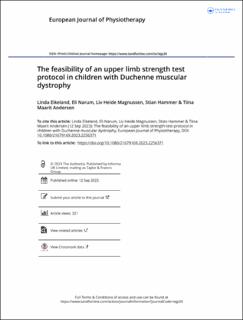The feasibility of an upper limb strength test protocol in children with Duchenne muscular dystrophy
Peer reviewed, Journal article
Published version
Permanent lenke
https://hdl.handle.net/11250/3113253Utgivelsesdato
2023Metadata
Vis full innførselSamlinger
- Import fra CRIStin [3604]
- Institutt for helse og funksjon [584]
Sammendrag
Question:
This study aimed to develop and assess a protocol for evaluating upper limb strength and its association with functional abilities in children and adolescents diagnosed with Duchenne muscular dystrophy (DMD).
Design:
A cross-sectional study.
Participants:
Eleven male individuals diagnosed with DMD (aged 11 to 18 years).
Intervention:
A systematic protocol for assessing the maximum voluntary isometric contraction (MVIC) of the upper limbs using grip and pull dynamometers was developed and conducted in conjunction with the Performance of Upper Limb (PUL) scale.
Outcome measures:
Feasibility was evaluated by appraising the number of participants capable of successfully executing the strength test protocol. Correlations were conducted to examine the relationship between upper limb strength and PUL scores.
Results:
The grip strength assessment was feasible for all participants, while the complete strength testing protocol was feasible for nine, excluding two individuals with non-ambulatory mobility. Significant correlations were found between overall upper limb strength and total PUL scores (rs = 0.742, p = 0.022), grip strength and distal PUL scores (rs=0.733, p = 0.010), shoulder abduction strength and PUL shoulder scores (rs=0.905, p = 0.005), and grip strength and overall PUL scores (rs=0.794, p = 0.004). The middle-level correlation was not statistically significant (rs=0.590, p = 0.094).
Conclusion:
The established strength test protocol demonstrated feasibility among ambulatory participants. However, alternative approaches are essential for those with limited ambulation. The study identified a robust correlation between upper limb strength and functional abilities. Further extensive studies are required to validate these findings.

